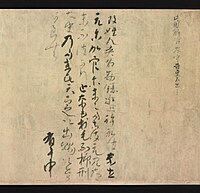
Photo from wikipedia
Abstract This study discusses the origin and development of the question particle me1 in Cantonese. An examination of the materials written in Cantonese between 1828 and 1955 reveals two unexamined… Click to show full abstract
Abstract This study discusses the origin and development of the question particle me1 in Cantonese. An examination of the materials written in Cantonese between 1828 and 1955 reveals two unexamined facts about me1. Firstly, besides marking a biased question, two centuries ago me1 was also used to mark unbiased questions, a usage that no long exists. Secondly, the pronunciation of me1 was rendered as mi1 in some texts. This study proposes that me1 was a fusion of the negative marker m4 and the particle ni1. The resulting form mi1 subsequently changed to me1 and from a high-falling to a high-level changed tone. Meanwhile, me1 has developed from a question marker to a discourse marker. Before the 1960s, statistics show that me1 was primarily a question marker and is now both a question marker and a discourse marker. Because of the frequent occurrence of a negative marker in me1-questions, they have become associated with negative presuppositions, a meaning that has remained, even in the absence of a negative marker. Phonological fusion is a major way of deriving particles in Cantonese and is closely related to word length, a characteristic which may explain the difference in richness of particles in Cantonese and Mandarin.
Journal Title: Lingua
Year Published: 2021
Link to full text (if available)
Share on Social Media: Sign Up to like & get
recommendations!